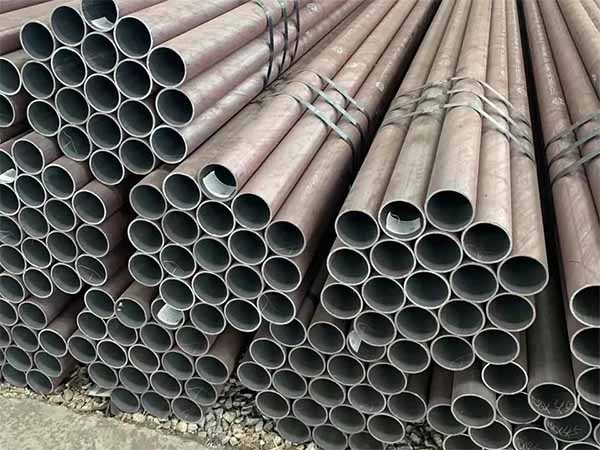For gas, water, air, and industrial fluid systems, the rated pressure of a
Schedule 40 pipe is one of the most important factors when selecting piping. This article will introduce the pressures that a Schedule 40 pipe can withstand, the factors that determine its rated pressure, and how the pressure varies with size and operating conditions.

What determines the rated pressure of a Schedule 40 pipe?
The rated pressure of a Schedule 40 pipe is not a fixed value; it depends on
four key engineering factors:
1. Pipe Size
Pipe size is the most important factor. Smaller pipes can withstand higher pressures, while larger pipes have lower rated pressures. For example:
A 1/2-inch Schedule 40 black pipe can withstand nearly 3000 PSI of pressure.
An 8-inch Schedule 40 black pipe can withstand approximately 700 PSI of pressure.
This difference arises because the rate of increase in wall thickness is much lower than the rate of increase in diameter.
2. Wall Thickness (Pipe Diameter Rating)
Pressure rating is typically calculated using the Barlow Formula:
P = (2 × S × t) / (D − t)
Where:
P = Working pressure;
S = Permissible stress of the pipe (Psi), e.g., S = 12,000–20,000 psi for ASTM A53 Grade B;
t = Wall thickness (in);
D = Outer diameter (in);
As wall thickness t increases, pressure P increases linearly;
With a constant outer diameter D, a thicker wall results in higher pressure resistance.
3. Material Grade
Pressure rating also depends on the grade of carbon steel and the manufacturing standard.
Common standards:
ASTM A53 Grade A/B
ASTM A106 Grade B
ASTM A500 Grade B/C
Higher steel grades generally offer better pressure resistance.
4. Operating Temperature
Temperature affects tensile strength; higher temperatures result in lower pressure resistance. For example, at 400°F (204°C), the pressure rating may decrease by 20% to 40%. Therefore, calculations must be performed based on actual temperature conditions.
Schedule 40 Black Pipe Pressure Rating
|
Nominal pipe diameter (NPS)
|
Outer diameter * wall thickness
|
Maximum pressure (PSI)
|
|
1/8
|
0.405 * 0.068
|
810
|
|
1/4
|
0.54 * 0.088
|
780
|
|
3/8
|
0.675 * 0.091
|
620
|
|
1/2
|
0.84 * 0.109
|
600
|
|
3/4
|
1.05 * 0.113
|
480
|
|
1
|
1.315 * 0.133
|
450
|
|
1.25
|
1.66 * 0.14
|
370
|
|
1.5
|
1.9 * 0.145
|
330
|
|
2
|
2.375 * 0.154
|
280
|
|
2.5
|
2.875 * 0.203
|
300
|
|
3
|
3.5 * 0.216
|
260
|
|
3.5
|
4 * 0.226
|
240
|
|
4
|
4.5 * 0.237
|
220
|
|
5
|
5.563 * 0.258
|
190
|
|
6
|
6.625 * 0.28
|
180
|
|
8
|
8.625 * 0.322
|
160
|
|
10
|
10.75 * 0.365
|
140
|
|
12
|
12.75 * 0.406
|
130
|
|
14
|
14 * 0.437
|
130
|
|
16
|
16 * 0.5
|
130
|
|
18
|
18 * 0.562
|
130
|
|
20
|
20 * 0.593
|
120
|
|
24
|
24 * 0.687
|
120
|
How to Select a Schedule 40 Pipe Based on Pressure
When selecting a Schedule 40 pipe, consider the following factors:
System Required Pressure: Gas pipelines, compressed air pipelines, and fire suppression systems have different pressure requirements.
Safety Factor: Industrial designs typically use a safety factor of 1.5 to 2.0.
Temperature of the Transported Medium: Higher temperatures require lower rated pressures.
Pipe Diameter: Smaller nominal diameters (NPS) can withstand higher pressure ratings (PSI).
Summary
The pressure rating of Schedule 40 black pipe varies with pipe size, material grade, and operating temperature. Generally, the reliable operating pressure range for SCH 40 pipe is from 690 PSI to nearly 3,000 PSI, depending on the diameter. Practical applications must consider operating temperature, medium characteristics, and safety regulations. During the project design phase, it is recommended to perform pressure verification based on ASME B31.3 and material measurement reports.
Read more:A complete guide to schedule 40 black pipe
